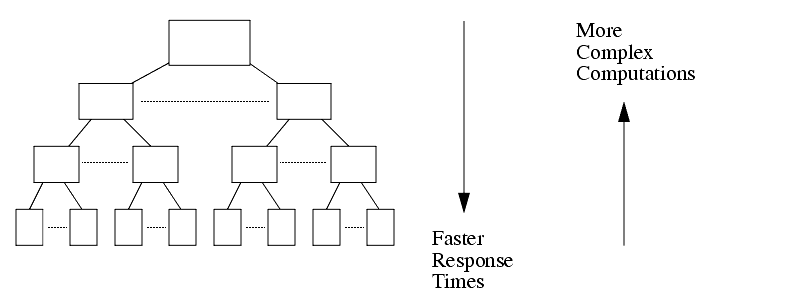
|
|
|
AO:3.1 OVERVIEW
������������AO:3.1.1 Distinguishing characteristics,
������������An automatic materials handling subsystem links machines in the system and provides for automatic interchange of workpieces in each machine
Automatic continuous cycling of individual machines
Complete control of the manufacturing system by the host computer
Lightly manned, or possibly unmanned
Characteristics of application,
Various measures of flexibility,
Major historical developments,
Humans are not without function in an FMS cell,
Computers provide essential support in a workcell for,
- DNC - Direct Numerical Control of all the machine tools in the FMS. Both CNC and DNC functions can be incorporated into a single FMS.
- Monitoring - collection of production related data such as piece counts, tool changes, and machine utilization
- Supervisory control - functions related to production control, traffic control, tool control, and so on.
FMS systems are intended to solve the following problems,
The most common problems in an FMS are,
Things to Avoid when making a decision for FMS,
Factors to consider in FMS decision,
AO:3.1.2 General Concepts
������������Manufacturing requires computers for two functions,
- Control - These programs must analyze sensory information, and control devices while observing time constraints.
A CIM system is made up of Interfaced and Networked Computers. The general structure is hierarchical,

The plant computers tend to drive the orders in the factory.
The plant floor computers focus on departmental control. In particular,
Process control computers are local to machines to control the specifics of the individual processes. Some of their attributes are,
The diagram shows how the characteristics of the computers must change as different functions are handled.

To perform information processing and control functions, each computer requires connections,
- Interfaced - Uses a single connection between two computers. This is characterized by serial interfaces such as RS-232 and RS-422.
- Networked - A single connection allows connections to more than one other computer. May also have shared files and databases.
- RS-232 (and other RS standards) are usually run at speeds of 2400 to 9600 baud, but they are very dependable.
- IEEE-488 connects a small number of computers (up to 32) at speeds from .5 Mbits/sec to 8 Mbits/sec. The devices must all be with a few meters of one another.
- Ethernet - connects a large number of computers (up to 1024) at speeds of up to 10 Mbits/sec., covering distances of km. These networks are LAN's, but bridges may be used to connect them to other LAN's to make a WAN.
- Mainframes - Used for a high throughput of data (from disks and programs). These are ideal for large business applications with multiple users, running many programs at once.
- Workstations (replacing Mini Computers) - have multiprocessing abilities of Mainframe, but are not suited to a limited number of users.
Search for More: |

Custom Search
|

|